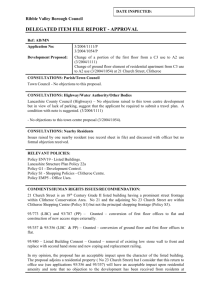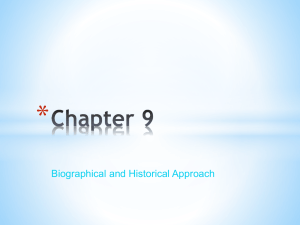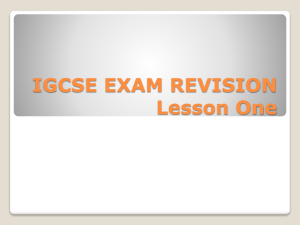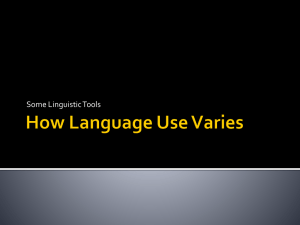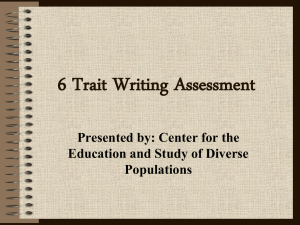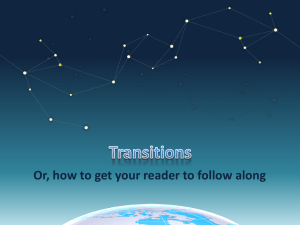Text 9 Great British Bus Journeys, David McKie
advertisement
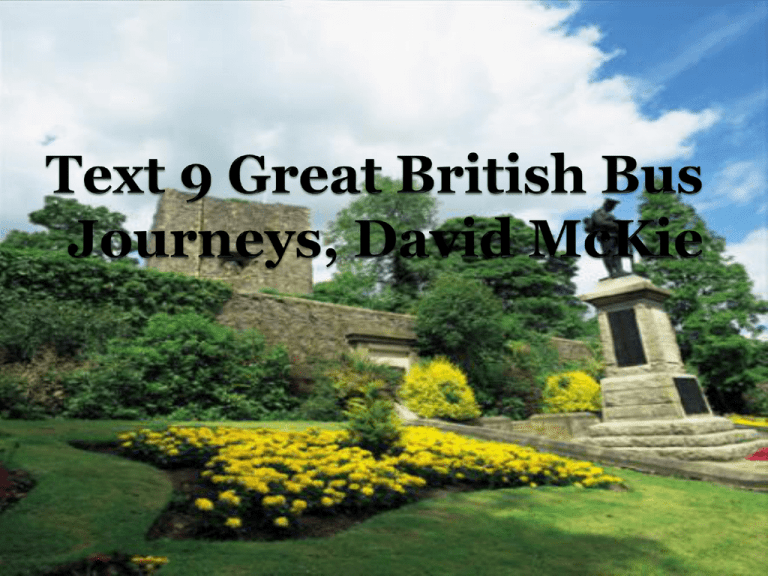
David McKie & Contextual Factors David McKie joined the Guardian newspaper in 1965 and became a political reporter. He later became the paper’s deputy editor eventually becoming the newspapers chief writer. His most recent book is ‘Great British Bus Journeys’ in which he describes his travels on buses around Britain. Reviews describe him as a digressive writer, constantly ‘rambling’ as he depicts a strong passion for the British countryside as shown clearly in text 9 “barely seeming to notice the gorgeousness of a journey they do everyday”. The book was based on his retirement plans to travel around the British Isles by bus and to write and record his experiences. His book was short listed for a 2007 travel writing award. Text 9 covers the part of the journey to and from Clitheroe. Clitheroe is a town based in the borough of Ribble Valley, Lancashire, England. It is often used as a base for tourists. The most well known building is ‘Clitheroe Castle’, which is argued to be the smallest ‘Norman keep’ in the whole country. It is one of the oldest buildings in Lancashire. David McKie works to restore and reclaim Britain to its glory, complimenting and embracing some of Britain’s most ‘unfashionable’ and unacknowledged towns. McKie rescues these cities and villages from their embarrassing reputation, and the deprecating attitudes towards them. Text 9 is an extract from this modern, non-fiction travel book, aimed mainly at Guardian readers who possess the same level of professionalism and education as this experienced and successful journalist. Therefore some readers may have simply bought the book because of the enjoyment they gain through McKie’s writing and their familiarity with ‘The Guardian’, whilst some may chose to purchase it because of their interest in travel writing. Context of Production and Reception Form and Structure The text is written in a first person nonfiction narrative and follows a chronological sequential order, consisting of four paragraphs. It is an extract from a non-fiction, factual book, written to mainly inform and describe whilst showing aspects of persuasion. The extract consists of three main elements, narration, description and dialogue. The piece is most likely aimed at a Western audience for intertextuality is used, mentioning successful western novels such as “Lord of the rings” and “Hound of the Baskervilles.” Furthermore, one can assume that the text is aimed at a reasonably welleducated reader, due to the mentioning of “Great Expectations” Charles Dickens, and the word choice throughout. Grammar The piece is written in a formal register and in the present tense, avoiding the text being distinguished with spoken speech. The writer creates a sense of immediacy, giving the reader a sense that they are travelling with the writer... “gives us all a huge benign smile.” There are a range of sentence types used, varying from complex with syntax including a number of subordinate clauses “This must be as blissful a summer day, in September, as we have had all this year, and perhaps,because the summer, such as it was, is dying, the most cherishable of all.” The large amount of commas used creates flow and reflects the speed and flow of travel and its constant continuation. Formal, standard grammar is used in line 9 ‘all of whom have been …’ Word Choice The lexis is sophisticated, using uncommon and formal adjectives and nouns “voluptuous” “endeavour.” A clear contrast is shown, when the writer quotes others who talk using non-standard forms “Omigod” perhaps mimicking their socialect. The piece is descriptive and informative, using a variety of positive pre-modifiers to describe the setting in the first paragraph “alluring” “green” “Pleasant” these all depict a positive attitude towards the countryside. Intertexuality is used when making reference to novels, stating that the countryside was a major influence and inspiration to the authors. This gives the sense that he is directing his text at higher educated Western people, who can relate to the novels and the writers enthusiasm. The use of the dynamic verb “texting” reinforces the idea that the text is aimed at Westerners, most likely the English. This is portrayed for he exudes a sense of patrionism and British pride, “Its another ride that reminds me what a beautiful country Britain can be.” In order to engage the reader, the writer uses interrogatives “do you really need anything more?” He is almost patronising the reader, and enforcing the idea upon them that the countryside is exactly what they need. Furthermore an imperative is used “Do not miss” conveying the fact that the writer has almost assumed the reader will visit ‘Clitheroe’. Moreover the writer creates humour, in order to entertain the reader “youngsters talk before they get down to serious business, like texting” The use of the bathos (anti climax) creates humour, for it is unexpected and slightly mocking the youth. Figurative Language David McKie’s use of positive pre-modifiers show his optimistic thoughts of places seen on the bus route 210 through Clitheroe. “Pleasant villages and alluring pubs” The use of the metaphors “voluptuous” and “tortoise pace” helps create a distinct image of the river, and walking pace of the old man. More specifically the word “tortoise” emphasises the age of the old man aswell as his speed. The use of alliteration also creates a vivid image of Clitheroe to the reader, by showing the magnitude of the height in which the town is located. “The town is set on a hill with higher hills ranged about it” The author’s use of interrogative highlight the positives about Clitheroe “If you’ve got Clitheroe, the town seems to be saying, do you really need anything more?” The use of dialect shows the authenticity of the people living in the town. “Omigod, I’ve lost my signal.” Text 5: ‘Walpole and Otranto, a traveller in Southern Italy’ By H V Morton H.V Morton ● Henry Morton was born 1892 in Birmingham ●He was a journalist, and edited the Daily Mail, The Evening Standard and The Daily express ● He served in World War One ● After leaving journalism he wrote many travel books including ones on the Holy Land and Palestine. Places that weren’t often visited ● His travels led him to write several notable books between the 1930s and 1960s About Otrantro ●Otranto is a city in southern Italy on the Adriatic coast ●This part of Italy was remote until the construction of a highway ● It’s most famous for Castello Aragonese , which is the setting for Horace Walpole’s novel The Castle Of Otranto ● In 1480 a Turkish fleet invaded the town and killed 800 Christians who refused to convert to Islam They were eventually repulsed from the city It would have been unlikely that any of the readers had visited Otranto because travel was exclusive until the 1960s, so there are a lot of descriptions and noun phrases to give visual descriptions. ‘Stoney earth’, ‘deep green sea’, ‘ancient castles’ He also uses figurative language and personification to Contribute to the visual imagery ‘The olive trees shimmered’ The verb shimmered suggests something valuable like a jewel And ‘The old streets struggled up a hill’ There are also some literary phrases like ‘Vague outlines pencilled against the sky and tipped with snow or cloud’ Morton uses emotive language to describe the events of the invasion. He describes the ‘powerful’ Turkish fleet which make us empaphise with the locals. He uses the word ‘massacring’ Which comes from old French and means slaughter, carnage and butchery He also quotes a priest’s reference to the victims as ‘martyrs’-People who suffer persecution and death for refusing to renounce a belief. ‘If you wish to see how we remember the eight hundered martyrs’ The use of present tense direct speech gives the reader a sense of being there To make his account more authentic, Morton includes words used by the locals such as ‘sacco’ and ‘fuedo’ and native dishes ‘pesce spada’ He also describes how the Italian pronounciation is meant to sound ‘In Italy the accent is on the ‘O’ not the ‘trant’ . The text is personal as Morton constantly uses ‘I’ and there are clear statements of personal opinion in the text ‘I thought Otranto the most beautiful little towns I had seen’ And exclamatory sentences ‘How beautiful are the colours in the south of Italy’ Form +Structure The opening paragraph sets the scene, and has a lot of imagery, “it was the sirroco that dry and hateful wind”. The use of past tense narrative resembles the style of the novel. The rest of the paragraphs zoom further into the detail of the place “view of this lovely emerald indigo sea and the white coastline”. As well as giving a description of the history “The Castle of Otranto was one of literature’s happiest chances”. GRAMMAR The use of the dynamic verb “plunged” emulates Mortons excitement and the start of a new journey. Loan words: used by the locals “sandolino”, “khamsin” reflecting the Prepositions: “beneath”, “above”, “behind” are used in this paragraph to give a sense of location and setting. Sentence Level Exclamatory sentence “ How beautiful are the colours in the south of Italy” emulating the beauty of the nature that the writer is experiencing. Syndetic listing: “olive oil, lemon, and origano” shows the writers enjoyment of the food and culture. Declarative: “I thought Otranto one of the most beautiful little towns I had seen” RURAL RIDES -William Cobbett William Cobbett Born in Surrey in 1763. He ran a newspaper: The Political Register – openly criticised the government. His paper was mostly read by the working class Cobbett fled to America, in a bid to avoid another spell in prison which he soon returned and continued to publish anti-government articles. During the time in which Cobbett wrote ‘Rural Rides’ there was Political, economical and social unrest in Britain (1821-26) Cobbett travelled the British countryside, to discover the state of the countryside’s economic well being, as he aspired to be a member of parliament. He was a radical journalist, politician and agriculturalist. His political views were proParliamentary reform and he was widely against the industrial revolution. Rural Rides… Cobbett toured Britain on horseback and wrote down his observations, which he published in his newspaper which later went on to become a book ‘Rural Rides’ The tone of the text… Cobett was trying to persuade his readers to believe his political views, through the use of hyperbolic lexical choice like “greater”. (line 1) Cobbett’s use of repetition emulates natural speech as it resembles a political speech and emphasises his point. (line 58) His use of Italics stresses and emphasizes his point. ‘…acknowledging your errors.’ (line 45) The use of metaphors “It was a sheep surrendering up the dogs into the hands of wolves.” (line 29) -The land owners are taking the land away from civilians and giving it to richer people.
